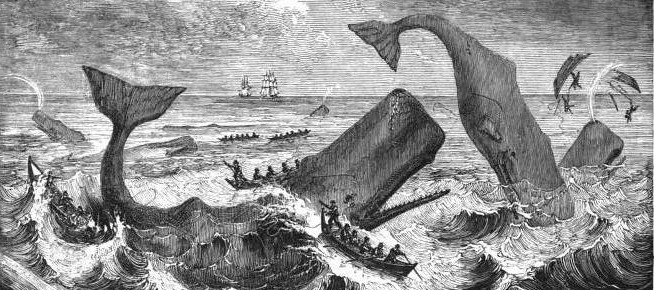
The Chasingflukes Students’ Guide to Reading Moby-Dick is comprised of
Context | Chapter Summaries | Glossary | Character-Sketches
[Context]
Under construction…
top
Chapter Summaries
From Etymology and Extracts to the Epilogue, the whole of Moby-Dick is here recreated, employing an em dash (—) summary technique adopted by an array of literatures and literary traditions; historical examples include: Milton’s Paradise Lost (1667), Gibbon’s The History of the Rise and Fall of the Roman Empire (1776), The Interesting Narrative of the Life of Olaudah Equiano (1789). Modern adaptations of this mode of prefatory “arguments” (as Milton called them) are to be found in Hunter S. Thompson’s Fear and Loathing on the Campaign Trail ’72 (1973) and Cormac McCarthy’s Blood Meridian (1985). Rather than meaning to take the place of reading the actual chapters of Moby-Dick, the aim of our Chapter Summaries is to provide a sort commentary on the book, an “analytical table of contents,” which not only clarifies the book’s contents by reproducing them in brief, but also preserves its complexity and obscurity by transcribing key quotations, formalizing character relations, corresponding separate sections of the book with use of hashtags (#) to highlight themes, and hyperlinking the content of the summaries to the Chasingflukes Moby-Dick Glossary and other helpful and relevant resources on the web.
top
Glossary
Glossaries today more often than not take the form of dictionaries, where individual words are set apart and accompanied by brief, explanatory definitions. The Chasingflukes Moby-Dick Glossary adopts the wider, historical sense of “glos” as commentary—explication, exposition, interpretation—on foreign, obscure, and/or antiquated elements of text. Owing to the famously intricate writing of Moby-Dick, the entries comprising this Glossary rarely have such a simple task as defining a single word. Invariably, riddling out one of Melville’s historical references or literary allusions involves confronting the complex ways in which these references and allusions relate to and already comment upon one another in the book; sometimes interpretations of Melville’s labyrinthian prose hinge on a puzzling turn of grammar, of which there are countless in Moby-Dick. Each entry in the Glossary is supported with images, videos, references to secondary materials, and/or links to reliable blogs in order to elucidate the more elusive lines in the book.
top
Character-Sketches
Coming soon…
One the most distinguishing and exciting features of the Reading Guide is its collection of Character-Sketches, because here you encounter more individualized responses to Moby-Dick. Whereas in the Chapter Summaries and the Glossary there is an effort to fuse individual voices (different researchers and different writers working at different times) into a common pedagogical voice, in the Character-Sketches more personalized written responses to Moby-Dick are preserved. Here we show, in another traditional literary form, that far more diverse than the characters of the book are the impressions that we can form of each character. To illustrate this fact, each entry is accompanied by an original pen and ink drawing, based on the written character-sketch rather than the representation of the given character in Moby-Dick.
If you would like to submit your own character-sketch for inclusion in the Chasingflukes Character-Sketch Gallery contact a Site Administrator with your name, location, affiliation/status, a .docx, .odt, or .pdf file of your character-sketch.
For more information on the form of the character-sketch, click here.
top
